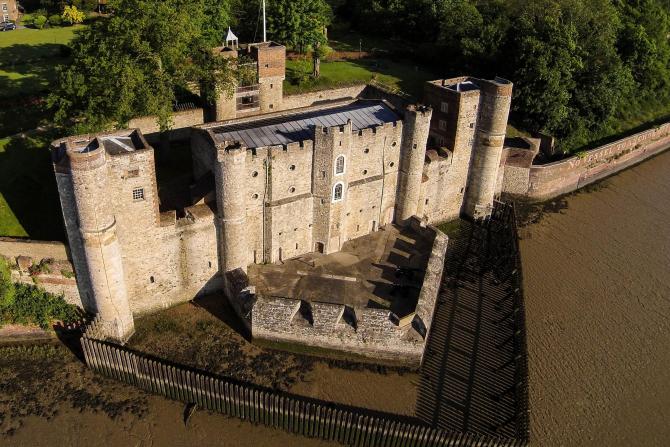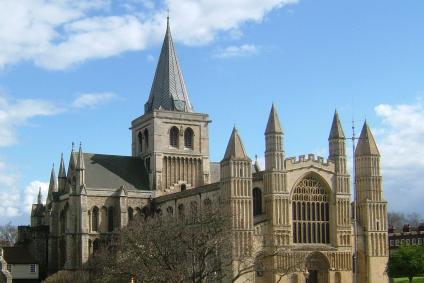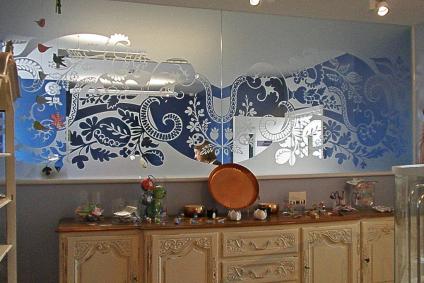Upnor Castle is an Elizabethan artillery fort located on the west bank of the River Medway in Kent. It is in the village of Upnor, opposite and a short distance downriver from the Chatham Dockyard, at one time a key naval facility. The fort was intended to protect both the dockyard and ships of the Royal Navy anchored in the Medway. It was constructed between 1559–67 on the orders of Elizabeth I, during a period of tension with Spain and other European powers. The castle consists of a two-storeyed main building protected by a curtain wall and towers, with a triangular gun platform projecting into the river. It was garrisoned by about 80 men with a peak armament of around 20 cannon of various calibres.
Despite its strategic importance, the castle and the defences of the Thames and Medway were badly neglected during the 17th century. The Dutch Republic mounted an unexpected naval raid in June 1667, and the Dutch fleet was able to breach the defences, capturing two warships and burning others at anchor in the river at Chatham, in one of the worst defeats suffered by the Royal Navy. Upnor Castle acquitted itself better than many of the other defensive sites along the upper Medway, despite its lack of provisioning. Gun fire from the fort and from adjoining emplacements forced a Dutch retreat after a couple of days, before they were able to burn the dockyard itself.
The raid exposed the weaknesses of the Medway defences and led to the castle losing its role as an artillery fortification. New and stronger forts were built further downriver over the following two centuries, culminating in the construction of massive casemated forts such as Garrison Point Fort, Hoo, and Darnet Forts.
History
Strategic context
The River Medway is a major tributary of the Thames, merging at an estuary about 35 miles (56 km) east of London. Its upper reaches from Rochester to the confluence with the Thames at Sheerness meander between sand and mud banks for about 10 miles (16 km). The water flows slowly without strong currents and is free of rocks, while the surrounding hills provide shelter from the south-west wind. These characteristics made the section of the river below Rochester Bridge a desirable anchorage for large ships, as they could be anchored safely and grounded for repairs. The complexity of the channel's navigation also provided it with defensive advantages.
During Henry VIII's reign, the upper Medway gradually became the principal anchorage for ships of the Royal Navy while they were "in ordinary," or out of commission. They were usually stripped of their sails and rigging while in this state and the opportunity was taken to refit and repair them. Storehouses and servicing facilities were built in the Medway towns of Gillingham and Chatham which eventually became the nucleus of the Chatham Dockyard. By the time Elizabeth I came to the throne in 1558, most of the royal fleet used this section of the Medway, known as Chatham and Gillingham Reaches, as an anchorage.
Although the Thames had been defended from naval attack since Henry VIII's time, when five blockhouses were built as part of the Device Forts chain of coastal defences, there were no equivalents on the Medway. Two medieval castles – Rochester Castle and Queenborough Castle – existed along the river's south bank, but both were intended to defend landward approaches and were of little use for defence. There was thus a pressing need for proper defences to protect the vulnerable ships and shore facilities on the upper Medway.
Construction
Upnor Castle was commissioned in 1559 by order of Queen Elizabeth and her Privy Council. Six "indifferent persons" chose a site opposite St Mary's Creek in Chatham, on 6 acres (24,000 m2) of land belonging to a Thomas Devinisshe of Frindsbury. It was acquired by the Crown – possibly compulsorily purchased – for the sum of £25. Military engineer Sir Richard Lee was given the task of designing the new fortification, but he appears to have been fully occupied with working on the defences of Berwick-upon-Tweed, and the project was carried out by others to his designs. His deputy Humphrey Locke took the role of overseer, surveyor, and chief carpenter, while Richard Watts, the former Rochester mayor and victualler to the navy, managed the project on a day-to-day basis and handled the accounting.
The castle's original appearance differed significantly from that of today. The arrow-shaped Water Bastion facing into the Medway and the main block behind it were part of the original design. There were also towers at either end of the water frontage, though these were subsequently replaced by towers of a different design. The gatehouse and moat were later additions. A number of derelict buildings in Rochester Castle, Aylesford, and Bopley were pulled down to provide stone for the castle. The main structure had been completed by 1564, but it took another three years and an infusion of extra funds to finish the project. The total cost came to £4,349.
Improvements and repairs
During the late 16th century, tensions grew between Protestant England and Catholic Spain, leading ultimately to the undeclared Anglo-Spanish War of 1585–1604. Spain was in a strong position to attack the south of England from its possessions in the Spanish Netherlands. New fortifications were erected along the Medway, including a chain stretched across the width of the river below Upnor Castle. The castle itself was poorly manned until Lord High Admiral Charles Howard, 1st Earl of Nottingham highlighted this and recommended that the garrison should be increased. By 1596, it was garrisoned by eighty men who were each paid eight pence per day (equivalent to £6 today).






